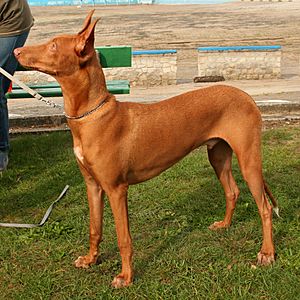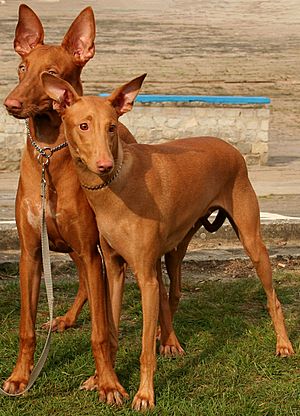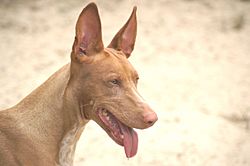Pharaoh Hound facts for kids
 |
|||||||||||
| Other names | Maltese: Kelb tal-Fenek | ||||||||||
|---|---|---|---|---|---|---|---|---|---|---|---|
| Origin | Malta | ||||||||||
|
|||||||||||
|
|||||||||||
| Domestic dog (Canis lupus familiaris) | |||||||||||
The Pharaoh Hound is a special type of dog breed. It is the national dog of Malta. In Malta, people call it the Kelb tal-Fenek. This means "rabbit hound" in their language.
This dog breed is quite rare outside of Malta. For example, in 2005, it was one of the least common breeds registered by the AKC in the USA.
Contents
History of the Pharaoh Hound

For a long time, many thought the Pharaoh Hound was one of the oldest dog breeds. Some believed it came from ancient Egypt. This idea was like a myth.
Modern Discoveries About Its Origin
New studies of dog DNA show something different. These studies reveal that the Pharaoh Hound is actually a more modern breed. It was bred to look like older dogs. So, it did not come from Egypt as some thought.
Where the Breed Developed
The Pharaoh Hound as we know it today was developed on the islands of Malta and Gozo. People often call it a sighthound. This means it hunts by sight. However, it mostly uses its strong sense of smell and hearing to find prey.
Why It's Called Pharaoh Hound
This breed came to Great Britain in the 1920s. People started calling it the Pharaoh Hound. This was because some thought it looked like dogs in old Egyptian paintings. You can see these paintings on the walls of ancient Egyptian pyramids and tombs.
Similar Dog Breeds
There are other dog breeds that look similar to the Pharaoh Hound. They likely came from the same family lines. These breeds developed on other islands in the Mediterranean Sea.
- The Ibizan Hound looks a lot like the Pharaoh Hound. But it has different colors. Ibizan Hounds are white with brown or tan patches. Pharaoh Hounds are always a solid reddish color. They can only have small white spots on their chest, toes, throat, muzzle, and tail tip.
- The Cirneco dell'Etna is another similar breed. It looks like a smaller version of the Pharaoh Hound. However, it has a completely different personality.
Appearance of the Pharaoh Hound
The Pharaoh Hound is a very elegant dog. It should look strong but not too bulky or muscular. Its head is long and shaped smoothly. It has only a small dip where the forehead meets the muzzle.
Its muzzle is a bit longer than its skull. It is wedge-shaped and finely built, but also strong. The eyes are oval and show a smart, noble, and keen look. The neck is long, lean, and muscular, with a slight curve.
The body is usually a bit longer than its height. Sometimes, it's the same length. The chest is deep and reaches down to its elbows. Its belly tucks up moderately. The shoulders are long and set back well. Its front legs are long and straight. The back legs are angled moderately and are parallel. They should balance with the front legs.
The tail is long and thin. It should reach a bit below the hocks (the dog's ankle joint). It usually hangs down. It should not curl between the back legs like a greyhound's tail. When the dog is excited, it carries its tail level with its back or loosely curled above it. Sometimes, the dewclaws (a small extra claw) are removed.
Pharaoh Hound Size
Pharaoh Hounds usually stand between 50 and 65 centimeters (22 to 28 inches) tall at the withers (the highest part of the back at the base of the neck). They weigh between 18 to 32 kilograms (40 to 70 pounds). They have a long, whip-like tail that sometimes has a white tip.
Pharaoh Hound Coat and Colour
The Pharaoh Hound has a very fine and short coat. It does not have any long, feathery hair. The coat can feel silky or a bit hard. It should never be so thick that it sticks out from the dog's skin.
The coat is always red. The shades of red can be different. Accepted colors range from mahogany to ochre to copper. Many other similar red shades are also allowed. Small white markings are okay on the chest, paws, tail-tip, and the bridge of the muzzle. Some dog clubs prefer a white tail-tip.
Its eyes are always amber in color. They should match the coat color nicely. The nose, paw-pads, and eye-rims should be the same color as the coat. Pharaoh Hounds have a cool special trait: they "blush" when they are excited or happy. Their ears and nose can turn bright pink!
Pharaoh Hound Temperament
The Pharaoh Hound is a friendly, calm, and smart dog. It is also playful and active. It might be a bit shy with strangers at first. But it is very loving with its family.
Hunting Instinct and Companionship
This breed has a strong hunting instinct. So, you need to be careful when it is around small pets. This includes cats, birds, and rodents. It is not a dog that shows its feelings loudly. Instead, it is quietly affectionate.
They are a vocal breed, meaning they make sounds. But they don't bark just for no reason. They make good watchdogs. This means they will let you know if someone is around. However, they are not good guard dogs. They are rarely aggressive with people. They form strong bonds with their owners. They should not be kept outside in a kennel.
Care for Your Pharaoh Hound
Pharaoh Hounds are independent thinkers. But they are also very trainable. It's best to use positive training methods. They are sensitive and do not respond well to physical punishment. Some Pharaohs can be a bit bossy, but it depends on the individual dog.
Grooming and Health
They have sensitive skin. Some shampoos (for dogs or humans) might cause allergic reactions. It's best to wash them with a gentle dog shampoo or human baby shampoo. Grooming a Pharaoh Hound is easy. You can just rub them quickly with a hound glove or a damp cloth. They are clean dogs and shed very little hair. They also don't have a strong doggy smell, even when wet.
Pharaoh Hounds are very active dogs. They need more than just a daily walk. They need a good run every day. But even though they are active, they should not be hyperactive.
Exercise and Safety
Because of their strong prey drive (their urge to chase small animals), you must be careful when letting them off leash. Only do this in a safe area. Make sure it is far away from roads or other dangers. If they see something they think is prey, they will chase it without thinking. No amount of training can stop them then.
They are also very good jumpers. Fences meant to keep them in must be taller than 1.52 meters (five feet). A fence of 1.82 meters (six feet) or higher is even better. Because they jump so well, they are great at the sport of dog agility. They are often called sighthounds. This means they can compete in lure coursing, where they chase a fake lure.
They can be sensitive to cold weather. Some might need a coat if they live in cold places. However, many Pharaoh Hounds enjoy snow. They can keep themselves warm by running, playing, and digging. This breed has very few genetic health problems. They can usually live for about 11 to 14 years.
How Pharaoh Hounds Are Used for Hunting
The Kelb tal-Fenek is usually taken out to hunt at night. There are fewer distractions then. Hunters typically take their dogs into the countryside. They release pairs of dogs, one male and one female, in different directions.
The Hunting Process
The dogs then search for their prey using their sense of smell. When they find a rabbit, the hounds chase it. The smaller, faster female usually leads. The male helps keep the rabbit from running too far to the sides.
At this point, the chasing dogs make a high-pitched bark. This sound attracts the other dogs and the hunters. Everyone comes running. By the time the hunters and other dogs arrive, the rabbit has almost always gone into a burrow.
The hunters then gather and leash all but one dog. They place nets over all the possible escape holes of the rabbit's burrow. Finally, the hunter takes a ferret from a round wicker basket. A small bell is attached to the ferret. The ferret is then placed into the last entrance to the rabbit's burrow.
The Kelb tal-Fenek can hear the little bell up to 3 meters (10 feet) underground. When the ferret makes the rabbit come out of a hole, the one free dog quickly catches it. Using ferrets for rabbit hunting was even mentioned by an ancient writer named Strabo. He wrote about it in the Balearic Islands when they were under Roman rule.
See also
 In Spanish: Pharaoh hound para niños
In Spanish: Pharaoh hound para niños




